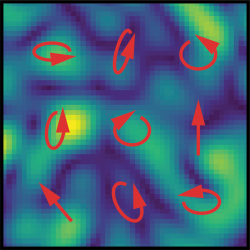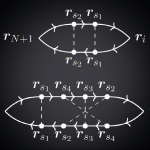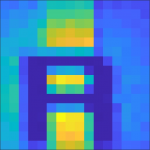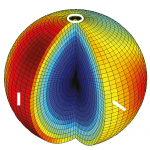PhD Theses

"Random matrix modelling of polarised light scattering in disordered media", Niall Byrnes (2023)
Abstract : The polarisation properties of light are often used as a means of information transfer, as well as in assessing the structural and compositional properties of materials. In many practical situations, however, the propagation of polarised light is impeded by random scattering, which tends to scramble the information content of the underlying fields. Theoretical study of the random scattering of light is an old, complex field of research, in which approximate, numerical methods are often favoured over exact mathematical analysis. Random matrix theory, in which systems are modelled using random scattering matrices, has uncovered universal properties of wide classes of random media, most notably in the field of quantum scattering. Despite also finding success in optics, a random matrix theory of polarised light has yet to be pursued. In this thesis we apply the notion of random matrices to develop statistical techniques for modelling the random scattering of polarised light. We present a full derivation of the symmetries of the vectorial scattering and transfer matrices that describe dielectric scattering media, including the scattering of evanescent wave components. We then consider the circular ensembles as a simple random matrix model and explore its implications for the scattering of polarised light. Moving beyond elementary models, a rigorous, statistical theory of the scattering matrix for discrete random media is presented, and exact mathematical results are derived in certain special cases. A numerical simulation method for studying scattering matrices describing random media of arbitrary thickness is then developed and validated against known physical phenomena. Finally, the techniques developed within this thesis are applied to the problem of the recovery of polarisation information within light that has propagated through a random medium.

"Random scattering of surface plasmons for sensing and tracking", Joel Berk (2022)
Abstract : In this thesis, a single particle biosensing setup, capable of sensing and tracking single nanoscale biological particles, is proposed and investigated theoretically. The setup is based on monitoring the speckle pattern intensity distribution arising due to random scattering of surface plasmon polaritons (SPPs) from a metal surface. An analyte particle close to the surface will additionally scatter light, perturbing the speckle pattern. From this speckle pattern perturbation, the analyte particle can be detected and tracked. Theoretical sensitivity analysis predicts a biological particle on the order of 10 nm in radius gives a fractional intensity perturbation to the speckle intensity of 10^−4, comparable to intensity contrasts used in existing interferometric scattering sensing techniques. A formula for the minimum detectable particle size is derived. In addition, an algorithm is derived capable of extracting the particle trajectory in the single scattering regime from the change to the speckle intensity perturbation over time and shown to be capable of errors ~1 nm on simulated data under optimal noise conditions. The effect of multiple scattering on the speckle pattern perturbation is studied, and it is shown that, by tuning the scattering mean free path and individual scatterer properties of a random nanostructure of scatterers on the metal surface, one can increase the magnitude of the speckle field perturbation by up to ~10^2. A neural network based localisation algorithm is developed to calculate the analyte particle position based on the speckle intensity perturbation and its performance on simulated data is studied. Mean errors on the order of ~20 nm were found, depending on the size of the region over which the particle must be tracked. Unlike the single scattering tracking algorithm, the neural network algorithm continues to function in the multiple scattering regime.

"Single pixel polarimetric imaging through scattering media", Kai Ling Seow (2020)
Abstract : Compared to pure intensity-based imaging techniques, polarimetric imaging can provide additional information, particularly about an imaged objects compositional, morphological and microstructural properties. The value of polarimetric imaging has already been demonstrated in various applications, such as early glaucoma detection and cancer discrimination. Its applicability, however, to practical in-vivo imaging situations is limited as the object of interest is often located behind a scattering layer, such as biological tissue, which scrambles both the spatial and polarimetric information about the object that is contained in the propagating light. As such, this work set out to find a means of conducting polarimetric imaging through scattering media.
Under the assumption that it is possible to illuminate the object plane with the required spatial patterns, single pixel cameras can enable imaging in scattering environments and were hence thoroughly investigated in this thesis as a route to polarimetric imaging through scattering media. A theoretical model for single pixel polarimetric imaging was first developed, and conditions under which the proposed method was feasible were identified and verified using 2D coupled line dipole simulations. The proposed method was further tested through experiments conducted using an in-house custom-built setup, composed of off-the-shelf components. To mitigate noise and to ensure that the obtained polarimetric image was physical, a constrained least squares algorithm was proposed and implemented. Experiments with various test objects hidden behind scattering phantoms showed that single pixel polarimetric imaging was able to successfully reconstruct the polarimetric images of the hidden object, whereas a spatially resolved detector in the same configuration resulted in an image that bore no resemblance to the test object. Further experiments that were conducted with the same test objects hidden behind chicken breast slices were, unfortunately, unable to recover an accurate polarimetric image of the hidden object. Additional investigations identified two factors that had likely affected the image reconstruction - spatial inhomogeneity and temporally varying transmittance of the chicken breast, both of which were unaccounted for in the data processing. On the basis of the experiments and simulations conducted in this work, single pixel polarimetric imaging was found to be a feasible approach for polarimetric imaging through scattering media. Finally, further improvements to establish single pixel polarimetric imaging as a practical technique are discussed.

"Informational limits in optical polarimetry and vectorial imaging", Matthew Foreman (2010)
Abstract : Light has provided the means to learn and gather information about the physical world throughout history. In a world where science moves to smaller scales and more specialised problems however, the boundaries of current technology are continually challenged, motivating the search for more sophisticated systems providing greater information content, sensitivity and increased dimensionality. Utilising the vectorial nature of light presents a promising avenue by which to meet these growing requirements. Polarisation can, for example, be used to transmit information, or alternatively, changes in polarisation induced by an object allow study of previously neglected material properties, such as birefringence and diattenuation.
Central to this thesis is thus the characterisation and exploitation of the opportunities afforded by the electromagnetic (i.e. vectorial) nature of light. To this end the work follows three running themes: quantification of polarisation information; formulation of simple propagation tools for electromagnetic waves; and development of specific polarisation based optical systems.
Characterising the informational limits inherent to polarisation based systems reduces to considering the uncertainty present in any observations. Uncertainty can, for example, arise from stochastic variation in the polarisation state being measured, or from random noise perturbations upon detection. Both factors are considered and quantified here.
Development of vectorial optical systems does, however, pose significant difficulties in modelling, due to mathematical complexity and computational requirements. A number of new tools are hence developed, as prove applicable to a wide variety of applications. Examples are naturally given.
To illustrate the potential of polarisation based systems, specific current topics are discussed; namely the growing demand for data storage, and single molecule studies. It will be shown that polarisation, can not only be used to multiplex information in data pits on optical media, but also to allow full 3D study of single molecules. Factors pertinent to such studies are studied in detail.